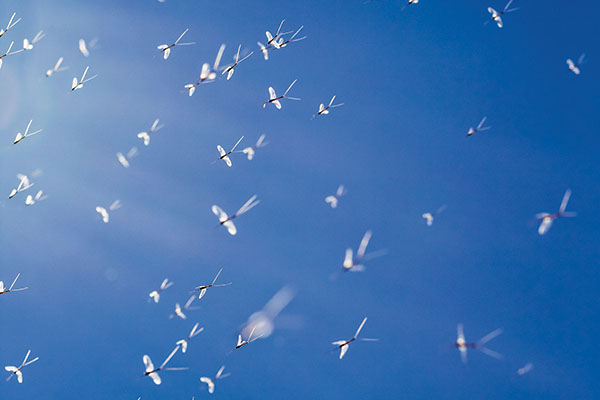
To most fly fishers, any mayfly hatch is cause for celebration. The purity of a cast that matches the rhythm of a rising trout is a treasured experience regardless of how often or how long you’ve been fly fishing.
While mayflies and dry-fly fishing are nearly synonymous among fly fishers, it is a rather sobering fact that these distinctive insects are usually smaller than size 14, and of dozens of different species, only three with broad distribution are large and important enough to be called “drakes.” I wrote about Green Drakes and Brown Drakes in previous issues of Fly Fisherman. Green Drakes have a reputation as the premier mayfly event of the season based primarily on their size and their ability to incite foolish feeding behavior even on some of the most pressured trout water. Brown Drakes are even larger insects, but with a smaller distribution so fewer fly fishers encounter them.
A downside to both hatches is a relatively short emergence duration, which usually lasts no more than a few weeks. Also, Brown Drakes are particularly susceptible to disruption from colder temperatures and wind.
Less known, even to the point of obscurity in some instances, is a mayfly of roughly equal size to Green and Brown drakes, but with considerably wider geographic range, and a duration that often lasts all summer. There are visual differences among the three drakes, but it is the behavior of Gray Drakes that may explain a lack of notoriety that is mostly unjustified.

Most fly fishers who pay attention to hatches understand that the majority of mayflies rise to the surface as they undergo the transition from nymph to dun. This type of emergence causes the insects to be well distributed on the water and keeps them constantly available to foraging trout until the duns take flight.
Commonly known as Gray Drakes, nymphs from the genus Siphlonurus only occasionally hatch on the surface in this typical mayfly fashion. Their primary pattern of emergence is to crawl onto shoreline rocks and vegetation, and then hatch in a manner more often associated with stoneflies. As a result, Gray Drakes do not usually appear on the water in great numbers until mating is complete and the females return to lay eggs on the surface as spinners.
As a result, Gray Drake hatches often go largely unnoticed by those with eyes trained mostly on open water. What is often overlooked are sporadic but aggressive riseforms that appear within a few feet of the bank. What is happening in this situation is also commonly observed with giant salmonflies when freshly emerged adults fall to the water with wings that are not yet dry or functional for flying. Wind also plays a role in carrying the newly winged insects to the water, much like what happens with terrestrial insects.
My experience has shown, however, that the right combinations of light and weather can cause Gray Drakes to hatch prematurely during their migration to the water’s edge. Almost invariably, this type of instream emergence takes place no more than a dozen or so feet from the bank, and a cool, overcast day seems to increase the likelihood.

While I have never witnessed a widespread appearance of Gray Drake duns, there have been times when a constant trickling of freshly emerged size 10 or 12 insects along the riverbank has tempted the attention of trout away from more numerous but smaller mayflies like Pale Morning Duns. In these perfect hatching conditions, a relatively sparse number of larger Gray Drake duns may be masked by a heavier volume of other mayflies emerging conventionally.
Because the seasonal emergence of Gray Drakes can encompass all of the summer months, their tendency to share the water with a changing variety of competing insects greatly exceeds Green Drakes or Brown Drakes, which are concentrated into a comparatively brief emergence period. For this reason, a selection of Gray Drake patterns stays in my vest from early June through September.
Depending on the weather or the point in the season, the timing of emergence can vary from late morning through early evening.
In the dun stage, Gray Drake is a reasonably accurate description when the insect is viewed casually at a distance. However, a slight olive tint shows up upon closer examination, and sometimes causes this fly to become confused with Green Drakes, which are often similarly sized. And while a side-by-side comparison reveals distinct differences in the coloration of body, legs, and wings, this case of mistaken identity may also explain why Gray Drakes have failed to establish a more notable individual identity.
Getting their Attention
Adding even more misunderstanding to the subject is a somewhat radical…





